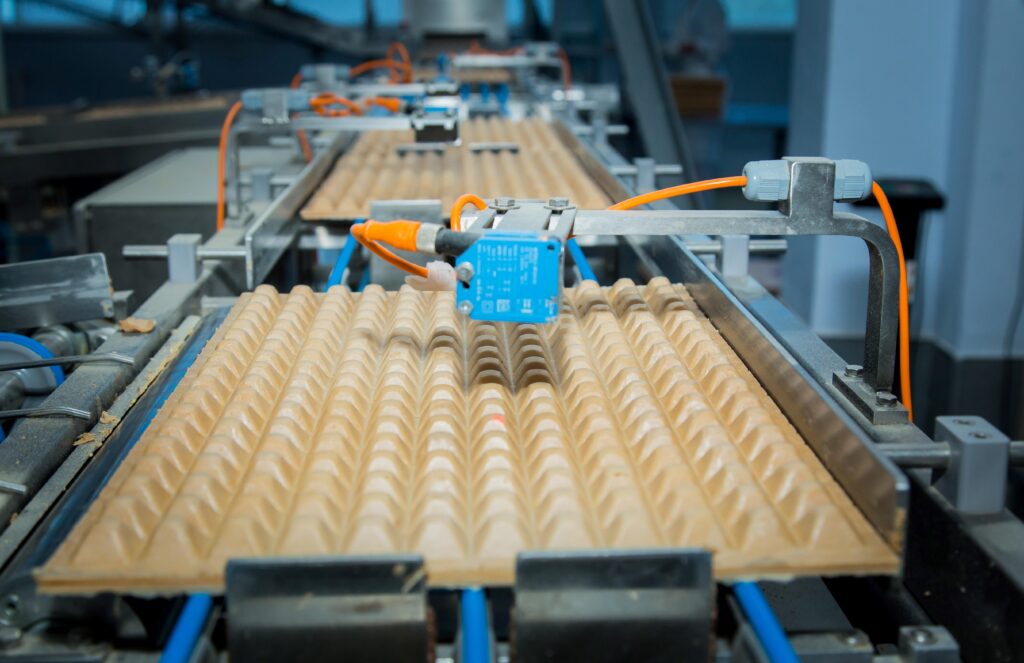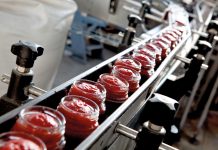 With the automation of production processes, companies can improve their efficiency and productivity as well as the uniformity of their products, reduce safety risks, optimize the management of resources, improve sustainability, all while maintaining the flexibility of production lines.
With the automation of production processes, companies can improve their efficiency and productivity as well as the uniformity of their products, reduce safety risks, optimize the management of resources, improve sustainability, all while maintaining the flexibility of production lines.
By Stefania Milanello
Food processing companies are aware that automation is playing an increasingly important role. This is why they choose to equip themselves with fully automated systems with integrated controls, monitoring and interface software, which complement each other. These technologies facilitate the creation of new tastes and shapes.
Advantages for confectionery companies
The advantages of production lines automation are many and cover different areas. Computerised production allows to improve the efficiency and productivity, to reduce safety risks, as well as to optimize the management of resources and improve their utilization. Information and automation-enabled technologies can also cope with changing consumer preferences.
Automation solutions provide information on the overall efficiency of equipment, so that firms can improve production operations and efficiency, reduce the variability of confectionery products, and gain visibility on information with less effort. Automation technologies are suitable for both, small and large companies, thanks to the flexibility and agility of operations. To meet consumer demand for new products, confectionery companies are continually introducing product varieties with new flavours and nutrients, or new packages, with higher service content.
Satisfaction with product quality will have an impact on future consumer purchases, and this requires monitoring of operations to meet and maintain high quality standards. On the other hand, competition on the market requires control and reduction of production costs where possible.
By installing data collection systems to monitor the machines and the line performance, the current status can be monitored, providing information necessary to analyse machine downtimes and determine the root cause of line problems. Line and machine control systems provide analysis and information on the workflow of orders throughout the entire plant, keep track of production and consumption, and determine performance throughout the process.
During the production process, the correct management of recipes and different production stages, as well as an accurate data collection and analysis are essential. Failure at any stage can lead to a loss of production time, waste, unforeseen maintenance. Supervision and control servers allow the operator to have a complete view of the line, to start, stop, pause and restart recipes and production steps at any time.
 Available solutions
Available solutions
In the confectionery industry, particularly for bakery products, the moulding, leavening and fermentation rooms, and oven control are of paramount importance. Environmental conditions can be fully automated, with total and instant control of parameters such as temperature, humidity, to obtain the desired product.
Not only the products but also the packaging must be flexible to market needs and changing consumer tastes. New needs demand flexible machine design and control of the packaging area. Control of packaging machines programming guarantees shorter format change times and better interoperability while meeting the new production requirements. Flexible and agile automations allow to resize the packaging as demand changes. Automated solutions – the robots – implement system safety to protect employees working in the different areas of production lines, including packaging.
Industrial automation, in fact, also includes the use of robotic devices to support production activities, such as high performance manipulators, palletizers and depalletizers, interlocking systems to filling machines, self-teaching multi-format production lines, i.e. with quick and automated format change-over, all with the possibility of being interconnected and connected to the Internet. There are machines, for example, able to accumulate products with buffer capacity so as to cope with line stops downstream and continue production without interruptions on the upstream line. Storage may also be temperature-controlled if the products in question require conditioning.
Also the unloading phase from an oven can be automated with great accuracy, in terms of speed and repeatability, thanks to robots that place the products in an orderly and precise way in order to make their packaging easier and faster. On the market there are machines capable of handling smaller and smaller packages, with different diameters, heights and weights, materials and closures.
Customization is one of the possibilities provided by automation. The dexterity of modern robotic machines is due to the development of increasingly adaptable, precise and sensitive gripping hands. The confectionery industry is one of the most automated of the food industry. Automation can be found in the preparation of the raw materials, in the mixing of ingredients, in the storage of liquids and semi-finished products in tanks that control the quantity by weight or level, while maintaining the correct storage temperature.
Scrolls and positive displacement pumps, scales and litre-counters ensure compliance with the programmed recipes, continuously fed machines ensure processing, decoration and stuffing, while provers and automated ovens guarantee perfect rising and baking. Packaging department, transport and handling of finished products have a high rate of automation.
The same goes for the chocolate industry, which can boast highly specialized and automatic machines such as the chocolate enrobing machine, cooling tunnels, melting tanks, tempering machines and dosing machines. The transport of confectionery products from one machine to another is done automatically with modular conveyors, with chains or roller belts, multi-way diverters, aligners, elevators, belt or roller bends, roller conveyors, pick-up trucks and so on. Also the preservation of the products at controlled temperature, where necessary, is also automated thanks to systems for the control and monitoring of ambient temperature and humidity.
RFID technology to safeguard quality
RFID technology allows to monitor different production stages. Various accessories/mounts for the production of confectionery products can be equipped with RFID data carriers for control and monitoring. Reading the data allows to trace the product path from the production to the warehouse.
The RFID system guarantees not only product monitoring, but also process optimization; it allows also production statistics to be monitored and optimized. Information is transmitted to the server of the line operator, which can store the relevant data of a production cycle. With RFID systems, every machine receives information that can be used to improve both the line productivity and production quality.
The RFID system is very useful also in logistics, as it allows to trace the path made by the carrier onto which it is applied within the production plant. The company has access to a series of data to be applied for line monitoring, for quality management as well as hygiene requirements. It is possible, for example, to verify if a cleaning cycle has been performed correctly. RFID technology alerts the operator in the event of anomalies with respect to a predefined standard.
 Inspection technologies
Inspection technologies
Modern technologies can guarantee confectionery companies the highest quality in terms of coding and marking, inspection and control and labelling, which best fit to different products, production lines, media, etc. These include industrial inkjet markers and heat transfer printers for foodstuffs, coding systems, X-ray inspection systems or metal detectors for the detection of foreign objects. End-of-line checks can be completely automated.
Thanks to automation systems it is possible to count the number of pieces produced, read bar codes, sort foods according to the colour, withdraw and discard those which do not comply. There is a variety of vision systems meeting the different needs of confectionery companies. There are systems for quality control, identification and traceability of food products, which can be installed even on high-speed production lines, guaranteeing efficiency and precision.
The Data Matrix system, for example, is a 2-dimensional (2D) barcode symbol on a square or rectangular grid. Its data capacity is greater than that of a linear or one-dimensional barcode, although it occupies a smaller space, so that a Data Matrix of 6 mm x 6 mm can accommodate up to 50 characters. In addition, Data Matrix symbols with a damage up to 20% remain legible without data loss.
It can be applied directly on the packaging. The OCR technology (optical character recognition), on the other hand, allows the optical recognition of characters such as expiry dates and batch numbers, the traceability of serial numbers, and the verification of thermal transfer printing. RFID technology can also be used in the end-of-line to trace the single food, to guarantee its authenticity.
Confectionery companies can use thermal imagers to inspect the sealing of packages, check the filling of containers or measure the temperature of equipment, refrigerated, cooked, pasteurized products, etc. without direct contact. Thermal imagers can be also used by confectionery companies for monitoring the uniformity of temperature over the entire length of the conveyor belt in the ovens. The installation and use of thermal imagers is simple. Furthermore, they are compact and can be installed anywhere.
Everything under control
The rational and efficient management of all production lines is essential to ensure product quality, prevent emergencies and unforeseen incidents, limit company costs and increase productivity. The complete management of the production lines and storage warehouses can be entrusted to a fully customized WMS software (Warehouse Management System), to meet all processing needs.
For example, the system is able to manage all stock codes, expiry dates and quality control, as well as constant temperature control to ensure the cold chain. Computerised MES (Manufacturing Execution System) systems, instead, support company management for the control and monitoring of production, for example on the status of their orders, work in progress, important production data supplied by the machines etc. MES solutions enable companies to optimize productivity and resource efficiency, thereby reducing losses.
The collection of production data makes it possible to identify any errors or deviations from the objectives set by the company in terms of quality, hygiene, product characteristics, reducing these negative effects and improving the production process. In logistics, it ensures the planning of stocks, product consumption and plant functionality, as well as detailed reporting to be provided to business partners if required.
Computerised systems make it easier for confectionery companies to verify supplier compliance and product traceability. Even sustainability benefits, as accurate reports allow real-time knowledge of the effects of the various production processes on the consumption of water, gas, electricity and heat, and to make the necessary adjustments to the equipment used.



